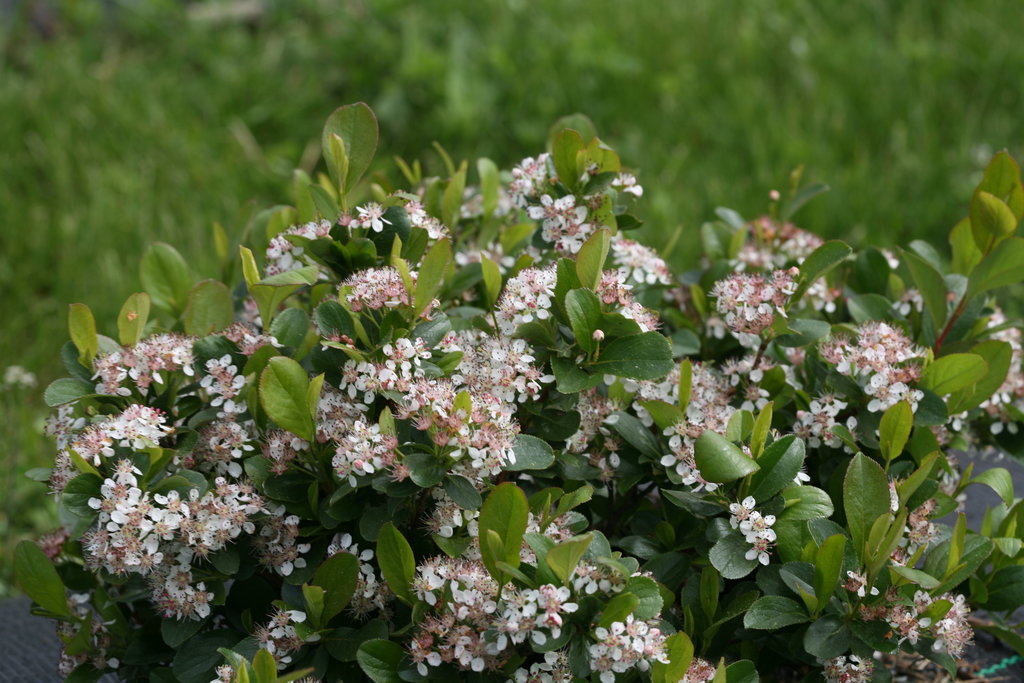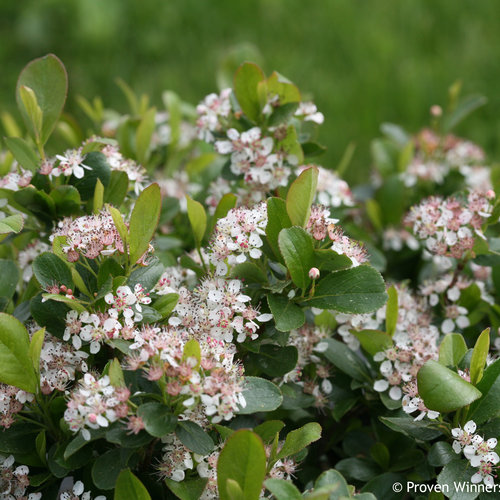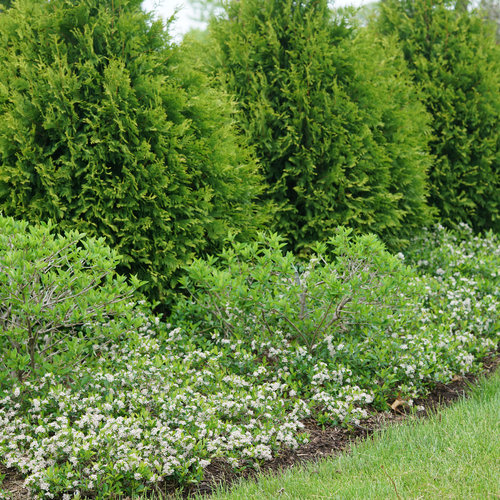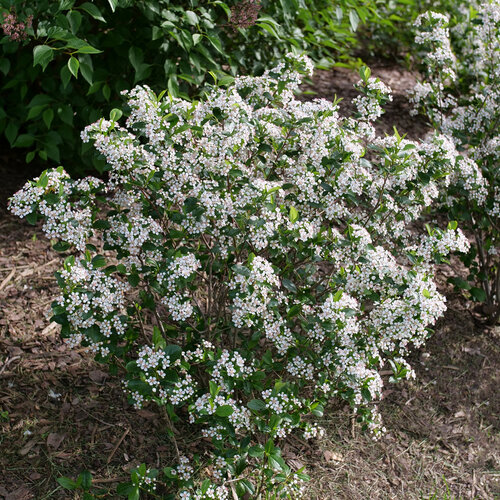Aronia - The Ultimate Growing Guide from Proven Winners®
Grow this low-maintenance native shrub for three-season appeal
 Buy aronia plants - order online and have them shipped right to your door
Buy aronia plants - order online and have them shipped right to your door
Aronia is a native deciduous shrub that produces clusters of scented white flowers and attractive dark green leaves in spring, followed by shiny red or black berries in summer and brilliant fall color. Although bitter-tasting, the berries are well-known for their health benefits and are enjoyed by wildlife.
There are two primary species of aronia, black chokeberry (Aronia melanocarpa) and red chokeberry (A. arbutifolia). Purple chokeberry (Aronia prunifolia) is a hybrid of the two, occurring where native habitat overlaps. Black chokeberry is the type most commonly grown in home gardens. Add this versatile easy-care bush to native landscapes, shrub borders, or use as hedging and screening.
ARONIA CARE & PLANTING
How to plant: When planting chokeberry, choose a site with at least 4 hours of sun and well-draining soil. Follow these steps and space plants 2 to 6 feet apart, depending on the variety.
- Loosen soil in the planting area. Dig a hole twice as wide and slightly deeper than the root ball.
- Remove the aronia plant from its nursery container and gently tease out roots if potbound.
- Set the plant in the hole with the top of the root ball level with the surrounding soil.
- Backfill the hole with soil, tamp down slightly to remove air pockets and water well. Water plants regularly until established.
Soil: Aronia can tolerate a wide range of soils including wet or clay soils, but does best in soil with good drainage. Mulch around the base of plants with a thin layer of compost which will feed plants, suppress weeds and retain moisture. Use a high-quality all-purpose potting mix for containers and make sure there are adequate drainage holes.
Find more shrubs that can tolerate clay soil.
Watering: Aronia prefers moderate water, but is tolerant of dry or wet soils. Provide supplemental water in prolonged heat or dry spells.
Fertilizing: This native shrub needs little or no supplemental fertilizer. If you wish, apply a balanced slow-release fertilizer in spring.
Pruning: Chokeberry shrub blooms on the previous season’s growth. When plants are finished flowering, remove dead or diseased branches and lightly shape as needed. If you prune it after flowering, you will remove the potential for berries, so it’s best to prune selectively and only when needed.
TRY THESE PROVEN WINNERS® VARIETIES
Chokeberry bushes come in a range of sizes and growth habits. Try some of these varieties in your landscape:
Zones: 3-9 Height: 12" - 2' Spread: 18" - 2' |
Zones: 3-9 |
Zones: 3-9 Height: 3' - 4' Spread: 3' - 4' |
ARONIA FAQ’s
Are chokeberries edible?
Despite the name, chokeberry is an edible superfood that is high in vitamin C, flavonoids and antioxidants.
What is the difference between chokeberries and chokecherries?
Chokeberry belongs to a different genus than chokecherry (Prunus virginiana). Chokecherry is also named for the bitter taste of the berries, which are edible and often made into jams, jellies or preserves.
Will deer eat chokeberry?
Deer will avoid eating chokeberry fruit because of the sour taste and smell. Plants are most susceptible to deer browse in early spring when food sources are scarce.
Where is the best place to plant aronia shrubs?
Plant on a site that gets at least 4 hours of sunlight a day. Aronia is tolerant of a wide range of soils including clay and wet soils.
How big do aronia bushes get?
Aronia plant size depends on the variety, ranging from 8 inches to 10 feet tall and 3 to 6 feet wide.
Does aronia like sun or shade?
Aronia can be grown in full sun to partial shade. Too much shade will result in leggy growth and fewer flowers and berries.
Is chokeberry invasive?
Chokeberry is native to eastern North America and naturalizes in woodlands, swamps and boggy areas. It is not considered invasive.
Do birds eat chokeberries?
Many songbirds including bluejays, cardinals, chickadees, cedar waxwings and thrashers consume chokeberries as a late-season food source.
How fast do chokeberry bushes grow?
Chokeberry bushes develop suckering roots that readily spread to form dense thickets and colonies.
ARONIA LANDSCAPING IDEAS
There are many ways to use aronia in your landscape. Here’s how:
- Plant a larger variety in a row to screen a property line or fence.
- Use medium-sized bushes in a foundation planting alongside other shrubs with ornamental attributes for season-long color.
- Plant a row of chokeberry bushes to divide garden rooms.
- Use a low-growing ground cover variety to edge a pathway or border or as a carefree lawn substitute in challenging areas. Find more ground cover shrubs.
- Add chokeberry to a rain garden alongside other moisture-loving plants. See the top 21 rain garden plants.
- Plant a smaller specimen in a container for an easy-care decorative accent. Find more shrubs for containers and small spaces.
- Create a native garden using chokeberry and other native plants to provide food, shelter and nesting habitat for songbirds and other wildlife. Find more native shrubs.
- Naturalize aronia plants along a slope for erosion control. Find more berry-producing shrubs.
ARONIA COMPANION PLANTS
Combine aronia alongside other plants with similar cultural needs of full sun to partial shade and well-draining soil.
For an ornamental fall border, plant chokeberry with:
- Prairie Winds® ‘Lemon Squeeze’ fountain grass
- Rockin® Deep Purple salvia
- Gatsby Pink® oakleaf hydrangea
- Mega Millions® black-eyed Susan
For foundation plantings, combine with other shrubs that bloom at different times such as:
- Sunshine Blue® II bluebeard
- Vanilla Spice® summersweet
- Very Fine Wine® weigela
- Summerific® ‘Holy Grail’ rose mallow
For a wildlife-friendly border that will support insect pollinators, songbirds and other wildlife, combine chokeberry with:
- 'Pardon My Cerise' bee balm
- ‘Miss Molly’ butterfly bush
- Red Balloon® viburnum
- Berry Poppins® winterberry
Find more shrubs to attract pollinators.
Buy Proven Winners plants:







